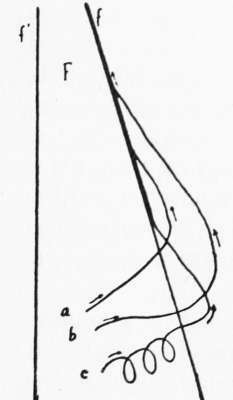Combination Of Differential Sensitiveness With The Tropisms
Description
This section is from the book "The Psychic Life Of Insects", by E. L. Bouvier. Also available from Amazon: The Psychic Life of Insects.
Combination Of Differential Sensitiveness With The Tropisms
As we have just seen, differential sensibility is subject to a certain number of laws which essentially distinguish it from tropisms, and on the other hand it is closely linked with them. Most often tropisms are associated with phenomena of differential sensitiveness in order to determine what the American biologists have designated by the name "behavior," and what we call in France the "comportement" of the animal toward external forces. A currant-worm directs itself toward the light upon a horizontal plane; one inclines this plane and the animal stops by differential sensibility to gravity, and then, after a turn or a reverse, it moves obliquely toward the light, satisfying, so far as possible, the exigencies of its positive phototropism and its negative ge-otropism.
Bohn (1904) has carefully studied the combination and the variations of these two kinds of phenomena from the point of view of light in the larvae of Tyria jacobœœ, which is common on the dunes of Wimereux, where, among the tufts of dune grass and the willow bushes, there grows in abundance the groundsel of Jacob which serves it as nourishment. For this caterpillar there is a lesser light above to which its phototropic reactions are negative, below positive, and this lesser light corresponds to the shade of plants which are exposed to the snn. When the caterpillars find themselves upon the sunlit -sand, their negative phototropism leads them to dark spots, that is, to the groundsels, or to the willows. They remain on the groundsels until they find the lighting which they like, but if they go to the willows where the shade is thicker, their differential sensitiveness leads them to another more favorable point, so that the groundsels growing among the willows or in a shady place "are much less often attacked than those which grow upon the sand of the dunes." In addition, the light action varies with the physiological condition of the animals, and parasitized caterpillars, or full- rown ones, go to obscure looks to transform to chrysa-lids.
More significant still are the recent experiments of Dolley upon the behavior of Vanessa antiopa, when this butterfly, deprived of the use of one eye, is placed in a shaft of light (Figure 2, F). The animal directs itself obliquely to the side of the well eye (right eye in the figure), either by a direct traject (a) or in a curved line (b), or by describing circles, which become a spiral (c). When by these movements it leaves the shaft of of light to pass into the shadow, which is very dark, it describes a curve in the direction of the obliterated eye, then proceeds toward the border (f) of the shaft, which it reaches without ever crossing it. Its abrupt passage from the light into the shadow has resulted in completely changing its direction. It obliques now to one side,, now to the other, as if it would avoid the direction which would lead it into the shadow. This is not all, for in its oblique march toward the side of the obliterated eye, the butterfly is led in the direction of the shaft of light. It reaches the border of this, but it is not able to cross it, for it penetrates at once into the light and immediately the sight of the intact eye leads it into the shadow, so it follows the border of the limit of the shadow and light. The numerous -and interesting diagrams of Dolley are surely the most demonstrative which have been used in this study, and they have so much the more importance in that the author draws from them conclusions which are contrary to the theory of Loeb. In fact, in his experiments Dolley has confused tropisms with differential sensibility without seeing the close bond between these two kinds of phenomena.

Fig. 2.-Track of a Vanessa antiopa blinded in the left eye and placed in a luminous ray F. (Three experimental diagrams a, b, c, borrowed from Dol-ley).
Continue to:
- prev: Relations Between The Differential Response And The Understanding Of Tropism. Continued
- Table of Contents
- next: Chapter V. Differential Sensitiveness-Species Memory, And Simulation Of Death. The Theory Of Trial And Error
